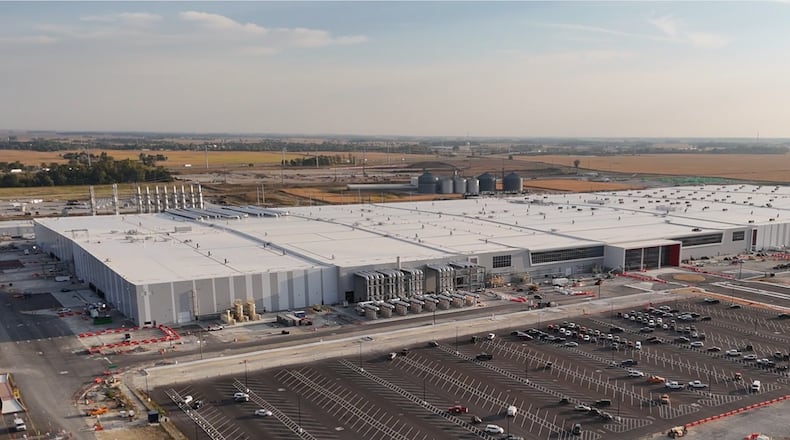While Honda and LG Energy are nearing completion of their joint venture’s electric vehicle battery manufacturing plant near Jeffersonville, Joby Aviation is starting to move machinery into a fledgling production site near Dayton International Airport, more than two years after leaders of Joby first announced local plans on the lawn of Hawthorn Hill in Oakwood.
But Intel’s plans for chip fabrication plants, west of Columbus, have stalled. Plants expected to open this year may not operate until 2030 or later — if ever.
These projects and others have benefited, or stand to benefit, from economic incentives and tax credits from the state:
• In October 2022, the Ohio Tax Credit Authority approved a 1.871%, 30-year Job Creation Tax Credit for Honda’s plans to create an “EV (electric vehicle) Hub” in Ohio. These plans involved several plants, including the joint venture battery plant in Fayette County. That credit had an estimated value of $71.3 million.
• In 2023, the Tax Credit Authority approved a 2.055%, 30-year Job Creation Tax Credit for Joby to produce its electric vertical takeoff and landing vehicles — sometimes called “flying taxis” — in Dayton. Joby’s credit had an estimated value of $93 million.
• Intel in 2022 received what Ohio leaders at the time said was the state’s biggest package of incentives, including a Tax Credit Authority-approved $650 million of job creation credits for fabrication plants in Licking County.
• In January this year, the Ohio Tax Credit Authority approved a 2.594%, 30-year Job Creation Tax Credit to support Anduril Industries’ planned manufacturing facility in Pickaway County. That tax incentive is worth an estimated $452 million.
Credit: AP
Credit: AP
As of early 2025, the state had 177 tax exemptions, credits or deductions worth more than $12 billion a year, which would amount to more than a quarter of the revenue the state collects, according to a new report from Policy Matters Ohio, a left-leaning think tank.
Put another way, this is more than the state’s total collection in personal income tax last fiscal year.
But Zach Schiller, research director for Policy Matters Ohio and a co-author of their report, argues that any payoff to Ohio is difficult to see.
“Ohio continues to underperform the nation, and it’s expected to continue to underperform the nation, on most of the key or many of the key economic indicators of economic health — job creation, unemployment rate, GDP (gross domestic product) growth, etc.,” he told the Dayton Daily News, referencing testimony in July from Ohio’s director of the Office of Budget and Management.
“That’s the single biggest deal that we’ve made,” Schiller said of the incentives offered to Intel, as an example. “Hopefully, it will still work out … (but) not only is it not operating, it’s not going to be operating for the next five years.”
‘An expensive credit’
Policy Matters Ohio called the Job Creation Tax Credit “the state’s leading economic development tax incentive.”
Says the report: “The governor anticipated in the budget bill that $705 million in such credits would be outstanding at the end of this biennium.”
But Schiller isn’t sure Ohio gets what it pays for, at least when it comes to that particular credit.
Ohio underperforms on key economic indices, as he sees it. “We’re on the brink of losing our status as the seventh largest state,” Schiller said.
Asked about Honda, whose joint venture EV battery project is nearing completion, Schiller responds with a question of his own: Were Ohio incentives critical in keeping Honda in Ohio, where the company has operated since the late 1970s?
“Show me the proof,” he said. “This is an expensive credit.”
He said he would accept the argument that Ohio needs to lower taxes and/or boost incentives, if the state had been offering these incentives for only a couple of years.
“But we’ve been doing it for decades,” he said.
Said Schiller: “It’s good to see that there are some high-profile projects. But most people don’t work at these places.”
‘Performance-based incentives’
A spokesman for JobsOhio, the state’s job creation arm, referred questions about the Job Creation Tax Credit to the Ohio Department of Development. He noted that JobsOhio is a private entity and, while leaders of JobsOhio can recommend a tax credit, taxes and tax credits are under the purview of state government.
“These are also performance-based incentives,” JobsOhio spokesman Matt Englehart said. “A company must first create the jobs before realizing the credit, and credits are not given unless the actual jobs are created.”
Mason Waldvogel, spokesman for the Ohio Department of Development, said the Job Creation Tax Credit is “not a blanket tax break.”
“It is issued only when companies deliver on their commitments,” he said. “Each approved project generates new payroll, local and state tax revenue, and long-term economic growth that would not occur if the investment happened elsewhere.”
Waldvogel noted Joby is still building its manufacturing facility. Its tax credit begins in 2026 and it’s not required to meet job creation goals until 2030. The company has to maintain operations during and after the term of the tax credit, otherwise the state can claw back the money.
“This approach keeps Ohio competitive while safeguarding taxpayer dollars through fiscal accountability and performance requirements,” Waldvogel said. “Companies earn credits based on agreed-upon job creation metrics, and no credits are issued until those jobs are created.”
‘Really busy’ in Jeffersonville
Rick Riggle, chief operating officer of L-H Battery Company, the joint venture between Honda and LG Energy Solution, referred questions about the importance of incentives and credits to Honda and LG.
“Honda is proud to partner with the state of Ohio and JobsOhio on how we can transform our operations amid the market and industry challenges of transitioning to electrification,” Honda said in a statement when asked if incentives were a key consideration for the company.
Honda’s statement said their partnership with the state led to a $1 billion commitment to retooling three existing Honda facilities; the commitment along with LG to a $4.4 billion battery plant; and will result in the creation of thousands of jobs.
“The support from the state — much like their support at other critical points of Honda’s investment in the 1970s and 1980s — will result in our shared success for decades to come," the statement said.
Longtime Honda employee Riggle — he worked for Honda’s Anna engine plant for 28 years — confirmed that the new EV battery plant is well on its way to producing batteries for the Acura RSX, scheduled to be introduced in the latter half of 2026.
“We’ve been really busy over in Jeffersonville,” Riggle said in an interview.
The plant is producing what he called “sample product” for Honda, completed batteries and battery modules meant for testing, not for sale to the public. Preliminary production is underway.
As of Oct. 6, the Fayette County plant had 543 full-time employees. Riggle said he welcomed 12 new employees that afternoon.
Trades workers even now are helping to complete the plant, performing final ductwork, starting up building systems such as fire alarms and paving parking lots.
Leaders of Honda have been careful to say that they will produce and sell vehicles that customers want. Even as Honda creates what it has called an “EV Hub” in Ohio, production of internal combustion engine automobiles will continue, the company has said.
At this point in 2023, Honda and LG were just putting up the Jeffersonville plant’s skeleton of steel.
“How far we’ve come in two years is really just incredible,” Riggle said. “Sometimes you need to stop, take a deep breath and look at that change because you don’t necessarily appreciate it every day. It has been incredible growth.”
Joby’s ‘manufacturing pipeline’
In a recent briefing before a Dayton Area Chamber of Commerce audience, Thomas Ubelhart, whom Joby has named to be the general manager of its Joby Aviation Ohio plant, said Dayton-bound technicians are finishing training at Joby’s plant in Marina, Calif.
“The training is top-notch,” Ubelhart said at the time. “The people I have on staff right now are the best you’ll ever meet. I would put them against anybody.”
Joby’s Marina site has a production capacity of 24 aircraft a year. But Joby has publicly announced commitments for aircraft that go beyond that number — some 300 aircraft in all, so far.
In recent weeks, Joby announced a deal to provide up to 200 aircraft to Saudi Arabian business network Abdul Latif Jameel. The business also has a deal with ANA Holdings in Japan. Those two companies have said they intend to establish a joint venture that will deploy more than 100 Joby aircraft across Japan.
The Dayton Daily News requested an interview with a Joby representative on its Dayton plans. Joby provided a statement from Greg Bowles, the company’s chief policy officer.
“To meet the growing demand for our aircraft means we have to scale production and finalize FAA (Federal Aviation Administration) certification at the same time — two of the hardest jobs in aviation,” Bowles said. “That’s why we’re doing the heavy lifting now in Dayton, building a certified manufacturing pipeline with high-skilled talent so we can deliver these aircraft the moment the clock starts.”
An Intel representative did not respond to questions. But in the past, Intel officials have said they remain committed to the Ohio project, and the office of Gov. Mike DeWine has expressed confidence that chips will one day be produced at the Licking County site.
Anduril in July completed an agreement to receive a $310 million grant from JobsOhio in addition to the state tax credits. Anduril is expected to create 4,008 new jobs and more than $530 million in new payroll over the next decade, investing at least $910.5 million in a site near Rickenbacker International Airport.
About the Author





